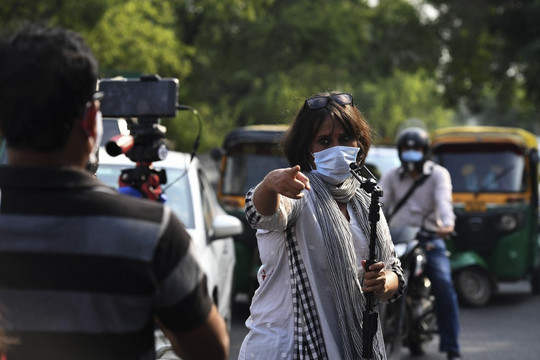Every five years, the GMMP analyses the place of women in news content. According to its latest report, published on 14 July, women only make up 25% of those portrayed in the news, a small 1% increase since the 2015 monitoring report. The 2020 report showed a decrease of the presence of women in health stories, very limited stories on gender-based violence and a positive increase of women experts and spokespersons as well as female reporters.
The report monitored stories published in newspapers, broadcasts and disseminated on news web sites and via news media tweets in 166 countries on one specific day. Given the extraordinary pandemic context, 25% of the stories monitored carried a coronavirus sub or principal theme.
The proportion of women as subjects and sources in digital news stories has also increased one percentage point overall from 2015 to 2020 with a three-point improvement on news websites and a three-point decline in news media tweets.
While an overwhelming majority of science/health news monitored by the GMMP teams was related to Covid-19, the report noted a fall in women’s voice and visibility in those stories. While the news share of science/health stories was significantly higher in 2020 compared to earlier periods (from 10% in 2005 to 17% currently), women’s presence in this topic declined by five points after a steady rise between 2000 and 2015. For example, women made up 27% of health specialists appearing in coronavirus stories , far fewer than the 46% world average given in labour force statistics.
Stories on gender-based violence have hardly made headline news, according to the report. When they do, women and girls are critically under-represented as subjects and sources. The report points to an increase in gender-based violence during the pandemic which has been poorly portrayed in the news, signaling "a serious deficit in news media accountability to women".
The report also highlights the absence of older women in the news with only 3% of women between 65-79 portrayed compared to 15% of men.
On a positive note, the GMMP points out the increase of women's voices as spokespersons and as experts (24% as compared to 19% in 2015).
Women's visibility as reporters has increased by 3% compared to 2015 across print and broadcast news. Four in ten stories are now reported by women, according to the GMMP.
Sarah Macharia, the GMMP global coordinator said: "It's clear from the 25 years of media monitoring that change is extremely slow. Incremental change is important, however small, as much as large leaps forward are. With the findings so far since 1995 we can safely do away with the expectation of great strides forward, so every statistically significant change in the right direction need to be noted."
As a strong supporter of ethical journalism, the IFJ has a long established tradition in fighting against discrimination of all kinds and promoting fair gender portrayal in the news. Its Global Charter of ethics for journalists states that "journalists shall ensure that the dissemination of information or opinion does not contribute to hatred or prejudice and shall do their utmost to avoid facilitating the spread of discrimination on grounds such as geographical, social or ethnic origin, race, gender, sexual orientation, language, religion, disability, political and other opinions."
Maria Angeles Samperio, the chair of the IFJ Gender Council said: "While there is a slight progress in the 2020 GMMP results, media must do much more to promote fair gender portrayal in the news. Lists of female experts, guidelines on how to adopt an intersectional approach in the newsroom, content monitoring and the creation of an inclusive working environment are a few of many solutions that can help change media's mindset towards gender equality. Trade unions have a role to play in ensuring that media fully endorse gender equality issues, both in news content but also in their collective agreements and internal policies".
IFJ General Secretary Anthony Bellanger said: "We are particularly concerned that the professional news space on social media is trending towards increased exclusion of women as subjects and sources with a 3% decline of their presence in news media tweets. With the increase in cyberbullying of women journalists, this is another blow to the presence of women on social media. We urge media organisations to reflect on the place of women on social media and take the appropriate measures to ensure they remain strongly involved in the democratic debate on social networks".

